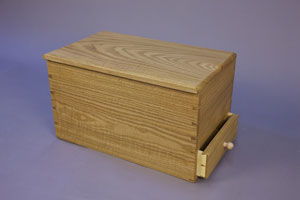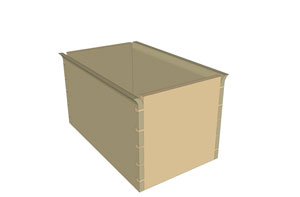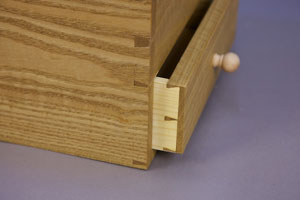 In learning any craft, the apprentice is indoctrinated with a plethora of rules. In woodworking, many are a matter of avoiding personal injury — as in safe use of sharp tools and machinery. Others are crucial to achieving workmanship-like results and producing furniture that will hold up to abuse for generations. (Woe is the practitioner who is ignorant of the laws of wood movement!)
In learning any craft, the apprentice is indoctrinated with a plethora of rules. In woodworking, many are a matter of avoiding personal injury — as in safe use of sharp tools and machinery. Others are crucial to achieving workmanship-like results and producing furniture that will hold up to abuse for generations. (Woe is the practitioner who is ignorant of the laws of wood movement!)
Just such a rule is: “There must always be a half-pin at either edge of a dovetail joint and not a half-tail.” Stated another way, there is never a half tail — and this is true whether you are hand or machine cutting. The reason for this ironclad tenet is that wood, left unto itself, has a proclivity to warp.
A box, drawer or carcass dovetailed together with half-pins at each edge is ironbound and  will resist any inclination of the wood to warp. However, this is not the case with half-tails at the edge, as we can see in the illustration. Should the wood warp, there is nothing holding the edges of the tail boards, and gaps will form. While I have exaggerated the phenomenon in my drawing, it is nevertheless unsightly.
will resist any inclination of the wood to warp. However, this is not the case with half-tails at the edge, as we can see in the illustration. Should the wood warp, there is nothing holding the edges of the tail boards, and gaps will form. While I have exaggerated the phenomenon in my drawing, it is nevertheless unsightly.
I recently had a group who wanted to build the box pictured, which is in John Kassay’s beautiful collection of measured drawings, The Book of Shaker Furniture. The 10” deep box measures 11” by 19” but has a 3” drawer in the bottom running the width and divided from the main compartment by a floating panel. The original is nailed to a board with a molded edge to form the bottom.
 This rustic workmanship niggled me, so I moved the drawer up ½” and trapped another floating panel to form a true bottom that would be immune to wood movement. The dovetail layout of this box is asymmetrical, making it a great training piece. However, wood warpage of the front and back tail boards could make the area around the drawer a poster child for Illustration I. The solution is a ½” rail below the drawer to resist wood movement.
This rustic workmanship niggled me, so I moved the drawer up ½” and trapped another floating panel to form a true bottom that would be immune to wood movement. The dovetail layout of this box is asymmetrical, making it a great training piece. However, wood warpage of the front and back tail boards could make the area around the drawer a poster child for Illustration I. The solution is a ½” rail below the drawer to resist wood movement.
The problem is that you cannot put two half pins on such a small rail. It needs a single center pin, leaving a half tail in the pin board. It is time to safely bend the rules as we see in the close-up photo. Although we threw the rulebook out the window, we have a box that will last for generations.
Epilogue: This box brings rave comments from all who view it and is a popular pick for a dovetail workshop. Once sanded and finished, however, it is not a particularly practical piece of furniture. It is too large for tabletops but not big enough for the floor. The drawer doesn’t hold much, and no one knows what the original was used for. Several months later, Susan and I are still looking for a use. Maybe my fungus collection …





